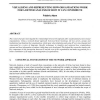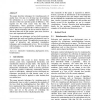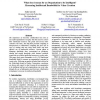26 search results - page 1 / 6 » Visualising and Representing How Organisations Work for a Be... |
ECIS
2001
13 years 6 months ago
2001
This research project investigated the relationships between IS staff and other organisational actors in four organisations. Using a network-based approach borrowed from Sociology...
AUIC
2006
IEEE
13 years 11 months ago
2006
IEEE
• This paper describes techniques for visualising pairs of similar trees. Our aim is to develop ways of presenting the information so as to highlight both the common structure of...
HICSS
2002
IEEE
13 years 9 months ago
2002
IEEE
The importance of electronic collaboration has risen as successful organisations recognize that they need to convert their intellectual resources into goods and services their cus...
SAC
2002
ACM
13 years 4 months ago
2002
ACM
Designing realistic multi-agent systems is a complex process, which involves specifying not only the functionality of individual agents, but also the authority relationships and l...
HICSS
2007
IEEE
13 years 11 months ago
2007
IEEE
Understanding collaborative work practices represents a critical factor in and a necessary fundament for the development of effective Computer Supported Collaborative Work (CSCW) ...



